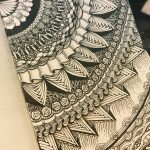Since its inception in the 1960s and 1970s, CBT has had a massive radiation in the broad Psychotherapeutic discourse. It is by large the most researched and practiced psychotherapy worldwide. CBT, the field’s golden standard, is the most viable treatment in regards to a wide range of medical and mental conditions. CBT’s influence, much like the leafy branches of a tree, stretching to reach the realm of creative processes, thus, reshaping how people perceive and engage with art. CBT, through the alteration of thought patterns, provide an easy access to innovative thinking faculties, and problem solving abilities. The notorious psychologist Dr. Aaron T. Beck, the father and founder of CBT, elaborated saying:
” The way we perceive our situation influences our feelings and behaviors “
In this regard, the fundamental axiom of CBT has a substantial impact on the creative process, empowering artists to overcome mental obstacles that might stand in the way of new possibilities and innovations.
What is Cognitive Behavioral Therapy. and CBT’s Influence ?
Cognitive behavioral therapy (CBT) is a time-limited, empirically supported, and structured form of psychotherapy. CBT, which was initially developed in the early 1960s by Dr. Aaron T. Beck, grounded in the axiom that thoughts, emotions, and behaviors are intrinsically interrelated, therefore, changing one can lead to changes in the entire structure. Extensive research has proven this approach effective in treating various mental health conditions, like depression, anxiety, and PTSD. Furthermore, its influence extends beyond traditional therapy settings, reaching stress management, resilience, and the broad self-development discourse.
CBT practices in the realm of artistic creativity enable individuals to overcome negative self-limiting beliefs and cognitive biases, hence increasing their creative potential. CBT assists artists, authors, and inventors to approach their work with an entirely different frame of mind, and reduced anxiety by recognizing, confronting, and reframing undesirable thought patterns, setting a healthy soil for creativity, novelty, and innovation.

What is The Relation Between CBT and The Creative Process ?
Studying the association between art and cognitive behavioral therapy offers an intriguing junction, where psychological concepts compliment creative expressions. According to relevant literature in this sector, CBT, known for attributes that alters thinking patterns, and ultimately, behaviors, can have a major impact on the creative process. Artists often make use of CBT techniques to break through blockage and manage performance anxiety, culminating in increased artistic production and inventiveness. Additionally, CBT helps artists reach deeper degrees of self reflection and creativity by treating deep-seated cognitive anomalies and emotional challenges, thereby facilitating a more genuine, and fruitful artistic expression.
Furthermore, the organized nature of CBT sessions supplies artists with skills to approach creative endeavors systematically, encouraging a healthy and sustained artistic practice. This symbiotic relationship between CBT and art illustrates the transforming capacities of merging psychological insight with imaginative endeavors, providing artists with an avenue towards improved mental health and enhanced artistic production.
What Happens in a CBT Session ?

In a standard cognitive behavioral therapy session, the therapist and the client work together to establish organized, goal-oriented plans that tackle specific obstacles and, thus, produce practical solutions. They collaborate on identifying the client’s core complications, typically centered on negative and sometimes compulsive thinking patterns, emotions, and behaviors. The session evolves as they actively examine these thoughts and core believes, delving into how they effect the client’s feelings and over all behaviors. The therapist challenges and reshapes misleading, negative, and sometimes irrational thoughts, using basic techniques such as Socratic questioning. Together they work to develop healthy and practical coping mechanisms and problem solving capacities. To further reinforce this process, the therapist often assign ‘homework’ to the client, which may involve activities such as practicing relaxation techniques, utilizing though diaries, or conducting behavioral experiments.







